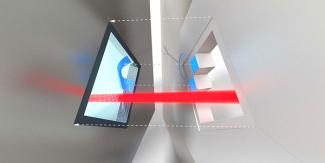The Regal-Lehnert collaboration has just taken a significant step towards the goal of one day building a quantum information network. Large-scale fiber-optic networks capable of preserving fragile quantum states (which encode information) will be necessary to realize the benefits of superfast quantum computing. Such networks will require new technology to reversibly convert low-frequency microwave light (i.e., electrical signals) to high-frequency infrared or visible light, without losing any information. The JILA collaboration has just made important progress toward developing a device that will be able to accomplish this conversion.
The two JILA groups partnered with researchers at NIST to build a converter that not only links the low-frequency microwave and high-frequency optical portions of the electromagnetic spectrum, but also preserves classical information encoded in the light. The converter works equally well in both directions and faithfully and efficiently transfers the information. The researchers responsible for this accomplishment were graduate students Reed Andrews and Robert Peterson, research associate Tom Purdy, Fellows Cindy Regal and Konrad Lehnert, and NIST scientists Katarina Cicak and Ray Simmonds.
The light-conversion experiment was reported online this week in Nature Physics. In the experiment, researchers transferred classical signals between microwave and optical light with conversion efficiencies of ~10%. The experiment worked so well that the researchers have calculated that if the device were cooled from its current operating temperature of 4 K to below 40 mK, it would be able to coherently transfer quantum states.
At the heart of the device is a silicon nitride drum that can “talk” to both microwave and optical light, which cannot otherwise communicate with each other. Infrared laser light passes through the drum near, but not touching, a miniature electronic circuit. Microwaves in the circuit cause the drum to vibrate, which alters the phase or amplitude of the laser light. Conversely, changes in the phase or amplitude of the laser light cause the drum to vibrate, producing an electrical signal that encodes the information in microwave light.
The converter (shown in the photograph) is actually quite small. The vibrating drum measures a millimeter on a side, while the top blue electrical piece is 250 µm long and the bottom blue square electrical pieces measure 170 µm on a side. When the device is closed and operational, the two halves are separated by about half width of a bacterium, or a bit less than 500 nm.
The next step for the Regal-Lehnert collaboration is quantum state transfer between microwave and optical light. The challenge will be figuring out how to get all the pieces perfectly aligned and cooled down to 40 thousandths of a degree above absolute zero. Stay tuned.—Julie Phillips




